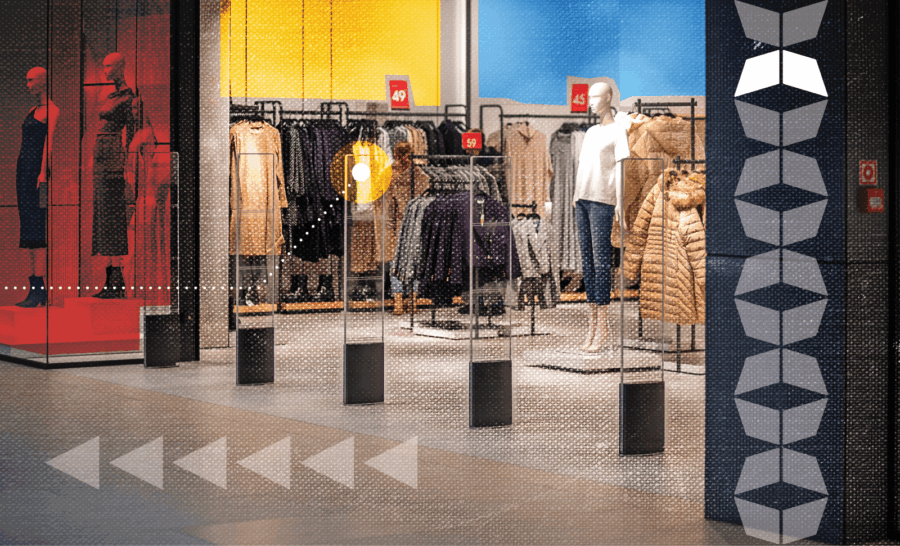Fighting Back Against Organized Retail Crime with Smarter Fulfillment
It’s easy for your mind to go to shoplifting or data theft when you hear the words “retail crime.” However, a far more insidious trend has emerged in the form of organized retail crime (ORC). Just like the name suggests, organized retail crime are more sophisticated operations run by criminal networks.
ORC goes beyond petty theft or grabbing a few items in a brick-and-mortar setting; it’s large-scale theft with the intent to resell valuable merchandise. These coordinated efforts often cross state borders and even run internationally. The theft rings target inventory throughout the supply chain in the hopes of making big grabs that yield high profits.
The goal is high-value items, such as electronics, designer goods, and pharmaceuticals. Groups often aren’t opposed to using violence or engaging in other serious criminal activities that include money laundering and trafficking.
According to the U.S. Chamber of Commerce, ORC is a growing threat that costs retailers $700,000 per every $1 billion in sales. Moreover, 57% of retailers reported a rise in organized retail crime over the past year. Many of these items are sold online under the guise of legitimate sellers, making it critical to prevent the problem before it occurs.
Since retail crime spans the supply chain, from shipping to warehousing, logistics partners become a crucial line of defense, using fulfillment strategies vital to thwarting ORC attempts.
The growing effects of organized retail crime
In 2024, the National Retail Federation (NRF), along with the Loss Prevention Research Council (LPRC), conducted a survey to address the growing impact of ORC. The survey addresses the rise in shoplifting, but more importantly, the type of shoplifting. Instead of a solo shoplifter, retailers are seeing multiple people participate in single incidents, driving ORC shoplifting. According to the report:
“More than three-quarters (76%) of those surveyed say that ORC shoplifting has grown as a concern in the last year. Unlike need-driven shoplifting, ORC typically involves a criminal enterprise employing a group of individuals who steal large quantities of merchandise from a number of stores and a fencing operation that converts the stolen goods into cash.”
What’s more worrisome is the rise in violence along with it. In turn, retailers are making tough choices that affect the customer. For instance:
- Retailers must invest more to protect product, including locks, surveillance, guards, cybersecurity, and more, that disrupt the customer experience
- Higher retail prices due to loss-related cost recovery
- Reduced product availability or out-of-stocks
- Delayed shipping and fulfillment timelines
- Stricter return policies and security measures
- Store closures or reduced hours in high-risk areas
Organized retail crime rings commonly target high-value, easy-to-resell products across a wide range of categories. Top items include apparel such as denim, handbags, and accessories, as well as electronics and their related accessories. Health and beauty products, fragrances, over-the-counter medications, and personal care items are also frequent targets due to their portability and street value. Food and beverage products, especially meat, candy, seafood, alcohol, and energy drinks, are often stolen in bulk. Other sought-after goods include power tools, hardware, laundry supplies, appliances, and even fine jewelry, including gold and gems. These items not only carry high resale potential but are often difficult to trace once removed from the supply chain.
While some the survey details in-store efforts, ORC transcends physical stores, targeting points along the supply chain.

How retail crime disrupts the supply chain
Supply chain challenges are already an issue without the added complexity of retail crime. The broader implications of ORC span everything from inventory accuracy and revenue loss to supply chain delays, chargebacks, shrinkage, and increased insurance premiums. For example, let’s say a shipment of high-value electronics is stolen during a trailer break-in en route to a regional distribution center. Not only are the goods lost, but the delay causes stockouts at retail locations, triggers chargebacks from major partners, and impacts customer trust.
In other cases, warehouse theft or intentional shipment diversions can quietly erode margins through ongoing shrinkage, while driving up the cost of insurance coverage due to repeat incidents.
Safeguarding the supply chain starts with using the right logistics partners that make strategic efforts to protect common weak points.
Weak points in fulfillment and supply chain that criminals exploit
It’s an unfortunate reality that strong security measures are essential across the supply chain. Product security also requires training and the right fulfillment technology. The following table highlights weak points that ORC groups commonly target:
| Weak Point | Description | How It Increases ORC Risk |
| Insecure facilities or lack of surveillance | Warehouses without proper fencing, cameras, lighting, or security protocols. | Makes it easier for criminals to break in, steal inventory, or tamper with shipments undetected. |
| Limited employee oversight and poor chain-of-custody procedures | Inadequate background checks, training, or process documentation. | Increases the risk of internal theft or collusion; hard to trace who handled goods. |
| Lack of real-time visibility into inventory movement | No GPS or inventory tracking systems in place across the network. | Delays detection of stolen or diverted goods, allowing theft to go unnoticed until it’s too late. |
| Third-party shipping handoffs without accountability | Use of unaudited or non-integrated carriers and brokers. | Creates gaps in responsibility where goods can be lost or stolen without clear ownership. |
| Complex or decentralized fulfillment networks | Multiple nodes, partners, and facilities operating without unified oversight. | Greater chance of miscommunication, inconsistent security standards, and overlooked vulnerabilities. |
Fulfillment strategies that deter and defend against theft
While theft still occurs, it’s not surprising that a few tactics have helped prevent robberies, break-ins, and outright theft. Think about what Ring has done for homes, tracking devices and cameras have done for cars, or the effectiveness of a good alarm system. It may not be perfect, but these tools and strategies do make a difference.
The same can be said for retail logistics and fulfillment operations; an investment in security can have a big ROI, starting with:
Secure inventory handling
A few small changes can enhance inventory handling, starting with requiring background check and well-thought-out training for all warehouse staff. Facility access needs to be controlled and monitored, and warehouses should use serialized inventory and packaging identifiers to track individual items throughout the supply chain, making it easier to detect tampering, prevent diversion, and ensure accurate chain-of-custody records.
Tighter chain-of-custody controls
It’s essential for businesses to know who handled what, when, and where, and fulfillment partners and businesses can work together to create a digital trail that ensures accountability at every touchpoint. For instance, scan-based receiving, picking, and shipping processes and secure transfer protocols between the warehouse and carrier. Every measure put in place reduces the risk of inventory loss during handoffs and helps deter internal and external heft while maintaining shipment integrity.
Real-time tracking and visibility
Monitor outbound shipments in real time using GPS tracking. This keeps shipments on the right path and schedule. If data is integrated across the network, there is end-to-end visibility of inventory location and movement. Businesses and 3PL partners can also automate alerts for route deviations, unexpected stops, or delivery delays to respond faster to anomalies and reduce the chance of theft or loss.
Warehouse-level safeguards
Think of physical security as the first line of defense against organized retail crime at the warehouse level. Efforts should include things like fencing, cameras, motion sensors, and lighting to deter unauthorized access and support incident investigations. Other proven tactics include smart locks, tamper-evident seals, and segmented zones for high-value or high-risk SKUs further enhance protection by controlling access and isolating sensitive goods from general inventory flow; optimizing warehouse layout can boost theft prevention efforts.

How a 3PL can help retailers fight back
A strategic 3PL partner can help retail businesses prevent and respond to organized retail crime. When choosing or changing partners, look for a 3PL that brings the infrastructure, expertise, built-in capabilities, and willingness to support operational control across the supply. This includes:
- Implements proven best practices for inventory protection
- Offers established facility security and chain-of-custody protocols
- Provides access to advanced tracking technology and centralized monitoring
- Screens and vets transportation providers through freight brokerage support
- Brings risk mitigation expertise and connections to insurance partners
- Helps reduce losses and improve control with WSI’s secure, compliant operations
- Aligns cross-functional teams, including operations, IT, and loss prevention
- Leads audits and risk assessments to identify vulnerabilities
- Develops SOPs and response plans for theft, disruption, and emergency events
- Trains staff at every level to follow secure processes and spot red flags
Smart fulfillment is a strong defense
Don’t wait until theft happens; review your current security protocols and your current fulfillment partner’s performance.
Fighting retail crime should not be reactionary. Modern businesses must build proactive strategies across their operations. Retailers have immense information at their fingertips, from leveraging data and analytics to identify patterns to guides to developing a resilient infrastructure and operations safeguards.
Fulfillment operations play a critical role in this effort, and choosing the right partners, processes, and technology can make all the difference. Retail crime isn’t slowing down, which means your fulfillment strategy can’t afford to stay static either.
Protect your inventory from organized retail crime: WSI helps retailers strengthen their fulfillment operations to reduce theft and improve supply chain visibility. Connect with our team to learn how our secure, compliant, and technology-enabled logistics solutions can protect your bottom line.
About the Author

Alyssa Wolfe
Alyssa Wolfe is a content strategist, storyteller, and creative and content lead with over a decade of experience shaping brand narratives across industries including retail, travel, logistics, fintech, SaaS, B2C, and B2B services. She specializes in turning complex ideas into clear, human-centered content that connects, informs, and inspires. With a background in journalism, marketing, and digital strategy, Alyssa brings a sharp editorial eye and a collaborative spirit to every project. Her work spans thought leadership, executive ghostwriting, brand messaging, and educational content—all grounded in a deep understanding of audience needs and business goals. Alyssa is passionate about the power of language to drive clarity and change, and she believes the best content not only tells a story, but builds trust and sparks action.



